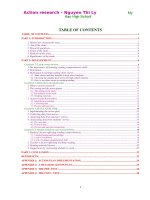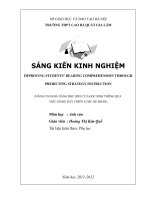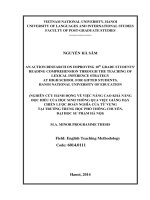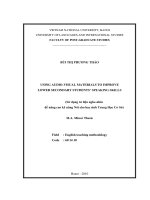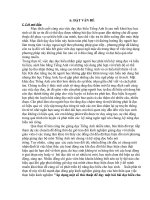skkn 11. sử dụng tư liệu trên internet để nâng cao khả năng đọc hiểu của học sinh (nguyễn thị hồng thúy - thpt mỹ hào)
Bạn đang xem bản rút gọn của tài liệu. Xem và tải ngay bản đầy đủ của tài liệu tại đây (234.92 KB, 16 trang )
Sở giáo dục và đào tạo hng yên
trờng trung học phổ thông mỹ hào
Sáng kiến kinh nghiệm
Sử dụng t liệu trên Internet để nâng cao
khả năng đọc hiểu của học sinh
Teaching experience
Improving reading comprehension
by using Internet-based reading materials
Họ và tên: Nguyễn Thị Hồng Thuý
Chức vụ: Phó Hiệu trởng Giáo viên tiếng Anh
Đơn vị công tác: trờng THPT Mỹ Hào
Mỹ Hào, tháng 5 năm 2010
Table Of Contents
PART 1: INTRODUCTION 2
1.1 Rationale . 3
1.2 Aim and objectives of the study . 5
1.3 Scope of the study . 5
1.4 Schedule ……………………………………………………….……… 5
1.5 Method of the study …………………………………………….………. 6
1.6 Time of fulfillment …………………………………….…….………… 6
PART 2: DEVELOPMENT …………………… ………………………… 7
2.1 LITERATURE REVIEW ……………………………………………… 7
2.1.1 Definitions of reading ………………………………………………….7
2.1.2 Internet-based reading materials ……………………………………….8
2.2. THE STUDY ………………………………………………………… 14
2.2.1 The contexts of the study ………………………………… ……… 14
2.2.2 Data gathering and analysis ……………………………………… 15
PART 3: CONCLUSION ………………………………………………… 17
3.1 Pedagogical implications ………………………… ………………… 17
3.2 Conclusion ………………………… ………………………………… 17
REFERENCE ……………………………………………………………….18
PART 1: INTRODUCTION
1.1 Rationale
Of the four language skills, reading seems to be the most important one because in
the learning process, it helps students develop other skills and provides knowledge on
the target language. Educational researchers have found that “there is a strong
correlation between reading and academic success”. In other words, a student who is a
good reader is more likely to do well in school and pass exams than a student who is a
weak reader.
Moreover, reading is very necessary for daily life. Reading can help us to achieve
some clear aims. For example, we read a road sign so that we know where to go. We
read the instructions on a ticket machine because we need to know what to do next.
Being aware of the importance of learning reading, authors of new English 10
have choosen interesting topics for reading lessons with the aim to promote students in
reading and improve their reading comprehension. However some of them are not
familiar with students genre and reading in the text book only is not enough to enhance
students interest in reading and reading comprehension. Successful reading depends on
the interaction of reading stratergies for processing the text, background knowledge and
linguistic competence. Thus besides the reading texts in the textbooks students need to
read more outside the classroom to enrich their vocabulary as well as their background
knowledge. That means students must read extensively.
In the last ten years educational circles have witnessed a dramatic shift from
seeing the computer as an adjunct or source of supplementary educational material to
treating it as a platform where effective teaching and learning can be promoted.
Computer assisted teaching and learning have become increasingly indispensable
components of mainstream education. This is particularly true for language
teaching and learning. With the recent advances in the computer technology,
especially in terms of the Internet, authentic target language is no more than a click
away. The Internet offers large amounts of authentic language in many languages.
The Internet provides opportunities to obtain instant and more interactive feedback
compared to traditional media such as textbooks, audio cassettes, etc. and an
environment where autonomous self-study language learning can be realized much
more efficiently and effectively. Rich multimedia components, low-anxiety, student-
centered learning environments, interest-driven materials are other assets the
Internet provides. At least in the areas of reading comprehension, preliminary
studies indicate that web-based activities may be probably beneficial. Considering
this wide spectrum of benefits of online language learning, we can claim that
online activities will pave the way for better learning gains for reading.
In fact, in Vietnamese high schools, teaching and learning reading are mostly
based on textbooks. Therefore, the sutents don’t seem to be interested in reading
lessons. Many of them find reading difficult and boring and even some are afraid of
reading. After reading a text, they don’t understand much about its content or they
misunderstand the author’s ideas.
As a high school teacher, I think that something has to be done about raising
students’ interest in reading and helping them comprehend the texts better. When
seeking for materials to design the lessons, I realise that internet is a useful source of
information for high school students to increase their background knowledge. Here, I
want to share ideas about the dificulties that the students in High schools in general, in
my school in particular encounter in reading lessons, how internet-based reading
materials are useful in improving high school students’ reading comprehension skills
and how to organize internet-based reading activities effectively. I will present three
types of internet-based reading activities that can help improve high school students’
reading comprehension skills.
1.2 Aim and objectives of the study
This study aims at improving the quality of teaching/learning English reading as
second language in the upper secondary education for Vietnamese students by using
internet-based materials.
To achieve this aim, the study sets out to obtain the three following specific
objectives:
1. To investigate the situation of learning reading with internet-based materials
among high school students in My Hao high school.
2. To find out how effective are internet-based materials in improving high
students’ reading comprehension.
2. To offer recommendations for the application of internet-based materials to
improve the students’ reading comprehension.
1.3 Scope of the study
Internet-based reading materials play more and more important part in raising the
effectiveness of teaching and learning foreign languages in general, English in
particular. This study focuses on the role of Internet-based reading materials in helping
improve reading comprehension skills for students in My Hao High school and offers
some suggestions for the intergration of internet-based materials in high school teaching
and learning curricular in Vietnam.
1.4 Schedule
To achieve the given aim, this study is intended to be fulfilled in 4 months, from
February to May, 2010:
February, 2010: making schedule, preparing detailed research proposal, seeking
for concerning materials.
March, April: Collecting data, analyzing and processing data, drawing
conclusions.
May: Writing research
1.5 Method of the study
With the aim of finding out the role of Internet-based reading materials in helping
improve reading comprehension skills for students in high school, a survey approach is
adopted for this study. Participants will be 43 students of class 11A12 of My Hao high
school. First, interviews will be conducted on a group of 20 grade 11A12 students.
These students will be randomly selected among the students of class 11A12. All the
interviews will be audio-taped and fully transcribed. Data will be analyzed qualitatively
to identify the situation of learning reading, the difficulties they encounter in the reading
lessons. Then all 43 students will be guided to use internet-based reading materials for a
month. Questionnaires will be conducted after that to find out if internet-based materials
help improve reading comprehension skills.
1.6 Time of fulfillment: By May 20
th
, 2010
PART 2: DEVELOPMENT
2.1 LITERATURE REVIEW
2.1.1 Definitions of reading
2.1.1.1 What is reading ?
Reading is a huge topic. It is a receptive skill. Reading can be defined as a
process, which involves a reader, a text and a resultant interaction between the
two. Reading is the process of constructing meaning from written texts. It is a complex
skill requiring coordination of a number of interrelated sources of information.
Reading is a holistic act. Success of reading comes from practice over long periods
of time. And also, there may be more than one interpretation of a text. The interpretation
depends on the background of the reader, the purpose for reading, and the context in
which the reading occurs.
2.1.1.2 Extensive reading
So many studies have been conducted to find out ways to improve reading
effectiveness. Recently, there have been a lot of reseaches about the effect of extensive
reading in improving students’ reading comprehension. Research suggests that one of
the best ways to help students increase their language proficiency is to encourage them
to read extensively. Krashen (1993), as a result of an examination of research on in-
school reading and "out of school" self-reported free voluntary reading conducted in
many different countries, concludes that free voluntary reading or sustained independent
reading results in better reading comprehension, writing style, vocabulary, spelling, and
grammatical development. The students who reported reading more English books
experienced significantly greater improvement in reading ability and vocabulary
knowledge than those who reported reading less. The students also reported that the
extensive reading program helped them to improve their English. Extensive reading is
believed to be not only more pleasurable, but also more beneficial for language
acquisition than instruction in grammar. Colin Davis suggested that any classroom will
be the poorer for the lack of an extensive reading programme and will be “ unable to
promote its students’ language developement in all aspects as effectively as if such a
programme were present”, he also claimed that such a programme will make students
more possitive about reading, improve their overall comprehension skills, and give them
a wider passive and active vocabulary. Strong (1996) also stated that “extensive reading
of literature can encourage students to develope possitive attitudes toward reading”.
2.1.2 Internet-based reading materials
2.1.2.1 Reasons for choosing Internet-based materials for extensive reading
Materials for extensive reading are available everywhere. But internet-based
materials seem to be the most suitable for high school students. There are several
reasons for choosing Internet-based materials. First of all, in recent years, the use of
the World Wide Web (WWW) as a resource for language learning materials has gained
increasing popularity among language teachers and learners. The Internet can now be
used for supplementing and reinforcing what we do in the classroom as well as
providing rich opportunities whereby students can start learning languages on their own.
Moreover, students generally have positive feelings about learning languages via
the Internet. I have interviewed some of my students about their attitudes towards
learning English through websites. Despite some difficulties encountered, they found
that students had an overall positive attitude to using websites in their learning of
English. Secondly, the Internet facilitates individualization of instruction and
introduces a more interesting platform to learn by incorporating multimedia into
the process. Thirdly, it enhances the accessibility of information, language
materials in this case, as well as offering various ways to connect with the target speech
community. Unlike traditional textbook-based teaching, language material on the
Internet can be updated periodically. Recent literature on methodological and
pedagogical considerations requires language learners to become active participants
in the process rather than passive recipients of information. In this age of
information explosion, language learners are encouraged to be explorers and creators
of language, and assessors of their own linguistic progress. Two other important aspects
are the issues of learner autonomy and motivation. Learner-oriented online language
teaching materials demand that the individual background of learners, their needs,
and learning styles are accommodated. In other words, learner-directed language
instruction provides learners with the control of choosing material, sequencing it, as
well as deciding on the pace of delivery. Communicative language teaching and learner
autonomy have become increasingly important for language teachers in the last few
decades. Students are no longer expected memorize lists of grammar rules and
vocabulary items but to understand and convey meaning with an adequate
knowledge of the form, use, and appropriacy of the language. They do not need to be
spoon-fed all the time. Mistakes are natural in the language acquisition process and
learners are encouraged to be willing to learn and to take responsibility for their
own progress. Finally, students at this age are curious and they like reading something
new, atractive and linked with modern technology. Internet-based materials are
plentiful with various topics.
2.1.2.2 Internet-based reading materials improve reading comprehension
Thanks to the ever expanding flexibility and versatility of IT in performing
many jobs, most of the language teaching authorities support using it in facilitating
teaching in general, teaching English in particular. With recent advancements in
software technology, multimedia computing and extensive use of the Internet,
computers have become so widespread in schools. Internet technology is a medium
of global communication and a source of limitless authentic materials. With the
emergence of the Internet technology, e-mail, list-serves, streaming audio-video, chat
rooms, audio-video and message boards, language learners now have more chances to
improve their language competence. Easier access in terms of distance and time
considerations, self-paced language study, low affective filter, increased
motivation, opportunities to access and use authentic language, and hence enhanced
learner autonomy are among the advantages of using the web in language teaching
and learning. Internet-based reading provides language learners with a much better
opportunity for initiative in language learning, enhancement of learning strategies.
Engagement in meaningful authentic exercises promotes enthusiasm and motivation
on the part of the learners. Internet-based reading helps create relaxed (in terms of
learner anxiety) environments. Internet-based reading establishes a basis for reflecting
on the experience of language learning, self-correcting, self-evaluating, and
searching for information on any linguistic and/or socio-cultural aspect learners
might want to learn more about right on the spot, something that cannot be realized
easily in traditional type of media.
The Internet as a resource can enrich and expand language instruction. The
teachers can integrate the Internet into a language curriculum. The most compelling
reason is definitely the convenience in accessing and obtaining an endless supply of
authentic materials in target languages. The WWW has brought the world to the
fingertips of each learner. Applying the WWW to foreign language teaching also
provides the opportunity to meet the Standards in several ways.
2.1.2.3 Types to internet-based reading
Here are three different types to internet-based reading, which can help students
improve their reading comprehension skills using the materials from the Internet.
a. Teacher-determined lessons
The reading activities and materials of this type are comparable to the computer as
an online electronic workbook. The teacher prescreens and selects reading materials or
cultural readings from Internet-based, designs comprehension activities, and makes
them available through his/her Web page. By pre-selecting and preparing the readings,
the instructor tailors the contents and tasks to the students' proficiency level. The tasks
are designed to support the reader's comprehension process focusing on textual,
linguistic and cultural features. Reading is a silent process that is best done individually.
The learners get to explore authentic reading materials outside of class at their own
pace. This frees up classroom time that can be spent more effectively getting students
involved in communicative language learning activities. Furthermore, depending on the
instructional program design, students' answers may be forwarded to the instructor.
Students' responses to reading tasks are limited by the capacity of the teachers’
packages. Tasks can be true/false, matching, or multi-choice answers, or short answers.
To create such activities, skills and expertise in language pedagogy, instructional
design, and some programming are required. The latter may include experience with
HTML editors, HTML or Internet-based authoring packages such as Half-Baked
Software, or WebCT. Other technological skills such as the use of scanners and graphic
programs are recommended.
b. Teacher-facilitated lessons
Internet-based reading activities that have gained most wide-spread attention and
popularity among language teachers and students are those in which the instructor
provides a set of learning tasks that engage the learners in exploring reading materials in
their authentic environments. The instructor determines a particular topic and set of
goals for his lesson, such exploring English wedding, American education. The teacher
prescreens and selects a set of sites to ensure its contents are appropriate for their
pedagogical goals. Through a particular task design, the instructor facilitates the
students' reading process and guides the learners to explore a variety of pre-selected
resources, thus providing a clear goal to be accomplished by the students. Furthermore,
the tasks should be designed so that they are not so broad that students wander aimlessly
through the material yet open enough to provide multiple paths, outcomes, and
interpretations, which can form the basis for classroom interaction. In this way, the
teacher controls the navigational scope and the number and kind of Internet sites that the
students access. Despite the restriction, the learner has some autonomy as the tasks
provide the learner a choice in the sites he or she accesses and explores. Task types
usually include comparisons, gathering factual information, descriptions, and short
summaries. The outcome of the student assignments is clearly defined, but open-ended.
The teacher's role can best be described as a guide and facilitator. The students follow
the teacher's lead but get to explore the contents themselves. Teachers should list the
most popular search engines such as Google, Yahoo
c. Learner-determined lessons
Learner-determined lessons follow an approach to integrating Internet-based
resources that is entirely learner-centered. The learners determine the topics, reading
materials, and the way they go about exploring the readings themselves. They decide on
the process and the product, formulate the goals, identify Internet-based resources, and
make a decision on how the outcomes should be evaluated. In this way, the students
take on the roles of self-directed and autonomous learners, and take full charge and
responsibility for their outcomes. The teacher only gets involved in the role of a
facilitator offering support and guidance throughout the process as much as necessary.
Types of assessment may include teacher-, self-, or group-assessment. Assessment of
learner outcomes may be teacher-directed or student-determined. Examples are short
writing assignments, essays, or mini-projects or presentations that show the students'
analytical and interpretative skills of cultural readings and texts. The technological skills
required to implement this approach are minimal. If the teacher is to provide guidance
to his/her students on searching the Internet, then knowledge about Web browsers,
search engines and their effective use are indispensable.
There is no doubt, the vast amount of authentic resources on the Internet provides
learners an opportunity to improve their reading skills. Yet, to make the integration of
WWW-based activities a successful learning experience, it requires effective
organization and presentation of that information.
2.1.2.4 Considerations in using Internet-based materials
As pointed out above, there are numerous convincing arguments in favor of integrating
Internet-based materials into a foreign language curriculum. At the same time, several
arguments can be made that ask for a more cautious approach when using the Internet.
The Internet is not an ideal way of delivering instruction, and there are numerous
challenges to overcome. First, there are still many limitations on interactivity and
bandwidth. Second, the hyper-linked structure and presentation of information on the
Internet may easily cause students to get lost. Third, we have no control over the quality
and accuracy of the contents of the information. In other words, the use of the Internet
resources completely depends on reader judgment, which presupposes solid language
proficiency and critical reading skills. Fourth, little theoretical and empirical research
actually exists that demonstrates how to make use of Internet-based materials or how to
design tasks that allow the learners to explore these materials and yield expected
learning outcomes. In the same vein, little is known about students' attitudes towards the
integration of Web-based readings in the foreign language curriculum.
2.2. THE STUDY
2.2.1 The contexts of the study
2.2.1.1 The students, their learning conditions
The subjects of this study are the students of class 11A12. It is a selected class. It
has 43 students (36 females and 7 males). The students are interested in learning
English. All of them desired to enter a foreign language college after they finish school.
They have been learning English for 6 years. Generally, they are at the same proficiency
level. However, during the years in lower secondary schools, the main method that
their teachers often used to teach them is the Grammar-translation one. Furthermore,
they were not provided with modern facilities that are necessary for their learning such
as cassettes ….Therefore, the students are not very active in class.
2.2.1.2 Setting
My Hao High school was founded in 1961. it is located in My Hao district, a
highly developed industrial area. It has got good teaching and learning traditions. It is
considered one of the best high schools in Hung Yen province. Especially, having
upgraded to a national standardized high school, in recent years the school management
board has considered the application of IT in not only managing but also in teaching and
learning to make real innovation on its way to develop. The school has a local network
with nearly 100 computers granted to learning activities. The computers are connected
to the LAN, providing access to the Intranet and Internet. 25 computers of these are
installed with software called Magic Class, which supports teaching and learning
English. Many other softwares are installed to help the teachers prepare E-lessons more
easily. Online lessons are useful sources that help motivate students in learning English.
2.2.2 Data gathering and analysis
2.2.2.1 Interviews
The interview data showed that 70% of the students are not interested in reading
lessons. The main reasons why students are not interested in reading lessons are their
lack of background knowledge as well as vocabulary about the topics they are reading.
Some topics are unfamiliar, some others are boring so the students find it difficult to
understand them. Some students say that there are texts that they have read several
times without understand anything. Moreover, time for reading lesson at high school is
limited. There are 3 English classes every week. In five or six classes, there is only one
for reading, it means that there is not much time for reading. In extra classes at school
the teachers tend to pay more attention to grammar exercises. The students have
opportunities to practise vocabulary but in separated sentences, not in reading texts.
Because teaching reading is time consuming, the teachers often neglect it. Large class
size adds to the difficulties the students encounter in the reading lessons. Another
important reason is their lack of motivation. ‘Practice makes perfect’, that is the reason
why teachers have to find ways to enhance students to read more so that they can
improve their reading ability.
2.2.2.2 Questionnaire
The questionnaire data showed that internet-based reading materials to some
extent can improve reading comprehension skills. Having observed the students during
the experimental time, I found that the students maintained a high level of interests in
reading electronic texts. The new learning environment motivated them and encouraged
them to read. More than half of the students indicated that learning reading on the
internet was really enjoyable. For them, it was much better than reading paper texts.
Approximately two thirds of the students thought internet-based reading materials can
promote their autonomy in learning. Electronic material can be made in a way that
students are exposed to important lexical, grammatical and cultural information multiple
times. Students can access to internet-based material at any time and in any location. 25
0f 43 students said that they could learn and remember new words better and more
easily. However, one third of the students had difficulties in using internet. Some were
not skillful in using softwares, some couldn’t find suitable texts, therefore, they wasted
a lot of time. They suggested that internet-based materials be downloaded and copied
for them.
PART 3: CONCLUSION
3.1 Pedagogical implications
The study indicates that computer-based material can lead to improve reading
comprehension. Teachers and curriculum designers need to consider the role of internet-
based reading material in the development of My Hao high school students’ reading
comprehension in particular and the English proficiency in general. The government
and education administrators should provide high schools with more modern facilities
so that students can access to internet more easily.
3.2 Conclusion
Above are some of my experiences in using internet-based materials for extensive
reading that can help students in high schools improve their reading comprehension. I
have presented three different types of lessons that engage students in developing
reading skills by exploring authentic Internet-based materials. None of these is absolute,
but to some extent, they can help teachers and students gain their teaching and learning
goals.
Once again, in light of the literature, we can argue that internet-based reading
materials with built-in dictionaries and audio/visual aids and the integration of the
opportunities the Internet offers, such as the links to interesting sites, further
supplementary material on socio-cultural issues of the target speech community,
pave the way for greater gains in reading comprehension, vocabulary acquisition,
etc.
REFERENCES
1. Blake, J. (1997). The virtual global village: The world wide web, instructional
technology and the communicative language classroom. Retrieved April 15, 2010, from
2. Brandl, K. (2002). Integrating Internet-based reading materials into the foreign
language curriculum: From teacher- to student-centered approaches. Language
Learning & Technology, 6 (3), 87-107.
3. Chun, D. M., & Plass, J. L. (2000). Networked multimedia environments for second
language acquisition. In M. Warshauer & R. Kern (Eds.), Network-based language
teaching: Concepts and practice (pp. 151-170). New York: Cambridge University
Press.
4. Hoang, V.V. et al. (2007) Tieng Anh 10. Educational publisher.
5. Kim, M. (2002). The use of computer in developing L2 reading comprehension:
Literature review and its implications. ERIC Digest: 472 671. Retrieved April 11, 2010,
from the ERIC database.
6. Kung, S-C. & Chuo, T-W. (2002). Students' perceptions of English learning through
ESL/EFL websites. TESL-EJ. 6, (1), Retrieved March 20, 2010, from
7. Su, W. Q. & Kinshuk (2002). Web-based computer assisted language learning. In
Proceedings of the Distance Education Association of New Zealand Conference
(DEANZ), 99-107, Wellington, New Zealand.
8. Warschauer, M. (1996). Computer-assisted language learning: An introduction.
Warschauer, M., & Healey, D. (1998). Computers and language learning: An overview.
Language Teaching, 31, 57-71.
XẾP LOẠI CỦA NHÀ TRƯỜNG NGƯỜI VIẾT
Nguyễn Thị Hồng Thúy


